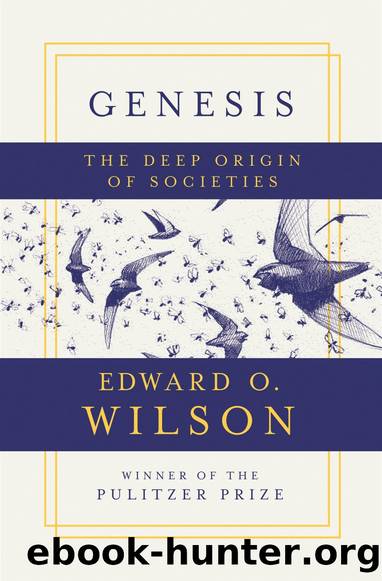Genesis: The Deep Origins of Societies by Edward O. Wilson

Author:Edward O. Wilson [Wilson, Edward O.]
Language: eng
Format: epub
ISBN: 9781631495540
Google: u4eQEAAAQBAJ
Amazon: 1631495542
Barnesnoble: 1631495542
Goodreads: 40180056
Publisher: Liveright
Published: 2019-02-06T00:00:00+00:00
Cryptocercus are large for cockroaches. They survive not by sprinting away from enemies in the expected cockroach-in-the-kitchen manner, but passively, relying on the protection of their heavy chitinous armor. They carry thick exoskeletons and shieldlike forebodies, and move at a dignified pace on feet armed with spines. They defend permanently fixed homes in the decaying wood of dead trees and tree limbs. Christine Nalepa, at North Carolina State University, has recently drawn together the anatomical and genetic evidence of the closeness of the Cryptocercus to termites in their way of life and social behavior. Like the modern termites, she points out, they depend on specialized bacteria or other microorganisms that live in their guts. These symbionts digest rotting-wood cellulose and share the components with their insect hosts. Further, both the Cryptocercus cockroaches and termites rear their helpless young in part by feeding them the digested wood components through their anuses.
The Cryptocercus colonies, like termite societies, are in fact bound inextricably by the necessity of passing symbiotic wood-digesting bacteria or other microorganisms from one generation to the next. The Cryptocercus societies are typical families, with parents attending their offspring who grow to mature full size and become parents in turn. Termites, among the ruling insects of the world, also have families, but of a very different kind. Most of their offspring do not become parents. Instead, they develop as workers that support their parents and sibling workers. In other words, they generate a growing community. Thus has risen the condition of eusociality, the potentially most complex level of social organization, in which individuals are bound together by necessity to form a single reproducing unit. As eusocial cockroaches, termite colonies have shifted from the Cryptocercus stage of social life, forged primarily by individual-level selection, to the next level up, creating complex communities forged primarily by group selection.
Which brings us to a major controversy that has festered within sociobiology. It began with a thought experiment by the British biologist J. B. S. Haldane conducted and published in the 1950s.
This great scientist, in positing what later came to be called kin selection, illustrated the idea with the following thought experiment. Suppose you see a man drowning. If you try to save him, you have a 10 percent chance of accidentally drowning yourself. The genes that prescribe your social response are, let us assume, fully in charge. If the drowning man is a stranger, saving him is not worth the 10 percent risk of your own death and thereby all your personal genes. Your genes will not benefit if you were to take such a risk even if successful. However, if the drowning man is your brother, carrying half your genes, the 10 percent chance of all your genes would make the rescue worth the risk. That is, from the point of view of the genes, chancing a rescue is all that matters in the course of evolution by natural selection.
In composing this scenario, Haldane recognized that kin selection has the power to evolve altruistic
Download
This site does not store any files on its server. We only index and link to content provided by other sites. Please contact the content providers to delete copyright contents if any and email us, we'll remove relevant links or contents immediately.
Bad Pharma by Ben Goldacre(3397)
How To by Randall Munroe(3074)
The Book of Numbers by Peter Bentley(2931)
Aliens by Jim Al-Khalili(2803)
A Short History of Nearly Everything by Bryson Bill(2662)
The Meaning of it All by Richard Feynman(2319)
Bill Bryson by A short history of nearly everything(1695)
A Short History of Nearly Everything: Special Illustrated Edition by Bill Bryson(1655)
Elephants on Acid by Boese Alex(1580)
Six Easy Pieces by Richard P. Feynman(1506)
Everything in Its Place by Oliver Sacks(1467)
The Meaning Of It All by Richard P. Feynman(1430)
Glukhovsky, Dmitry - Metro 2033 by Glukhovsky Dmitry(1344)
Bad Science by Ben Goldacre(1312)
When Einstein Walked with Gödel by Jim Holt(1286)
The American Scene by Henry James(1230)
One Two Three ... Infinity: Facts and Speculations of Science by George Gamow(1227)
Leviathan Wakes by James S.A. Corey(1213)
A SHORT HISTORY OF NEARLY EVERYTHING by bryson bill(1195)
